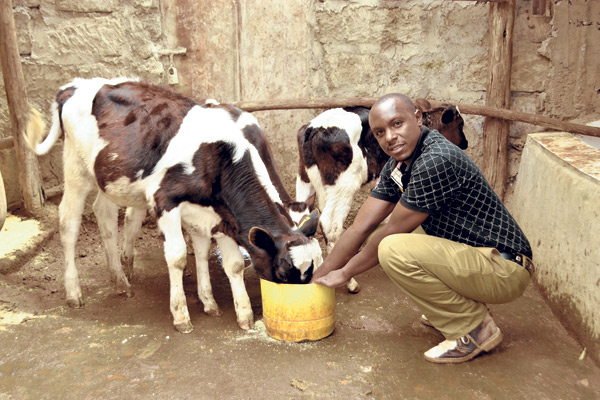How to feed a calf: Calves are the foundation on which the future of any dairy enterprise is built. If good replacement heifers are to be found, the management of calves must be effective. Calf management starts even before she is born to the time she is weaned.
With good feeding regime and routine practices, death cases are reduced even at the time when she is being born.
The calves remain healthy, grow fast into replacement heifers and start production early, hence rapidly contributing to genetic improvement and overall growth of the farm.
A few days before birth, the pregnant cow which at this time shows the signs of calving should be put into a maternity paddock, separate from other cows.
The paddock allows for closer monitoring and should be kept clean with fresh water provided.
During calving down, provide assistance when necessary to avoid difficulties and deaths at birth. After birth, first ensure that the calf is breathing. If having difficulty in breathing, assist it by removing mucus from nostrils.
If still not breathing, hold the calf by the rear limbs upside down, swinging it several times. Next tie and cut then disinfect the umbilical cord using iodine or solution of copper sulphate.
FEEDING THE CALF
During the first to second week, separate the calf from the mother or dam and start feeding her by hand. Feeding should meet the calves’ nutrient requirements, aim at reducing deaths, encouraging rumen development and maintaining a daily growth rate of approximately 0.4 to 0.5kg.
This weight, however, varies with breeds. The feeding strategy, however, changes depending on the start of weaning.
First week of birth: After the calf is able to stand, allow it to suckle colostrum at will from the mother. The suckling should be assisted by directing the muzzle towards the udder if the calf is not able. Colostrum absorption is highest within 12 hours after birth and very low after 24 hours.
As such, the calf must suckle colostrum immediately after birth, most recommended within an hour or two. Excess colostrum can be stored or fed to other calves when still fresh.
Generally, colostrum has antibodies that pass immunity to the calf hence protect it against diseases the mother might have been exposed to. It is also a rich source of nutrients as it has high amount of energy and protein compared to milk.
Second week: Colostrum feeding continues for about four to five days. Though up to this time, the rumen of the calf is not yet well-developed but has a groove formed that help deliver milk straight from the oesophagus to the abomasum (true stomach), restricting solid feed to pass.
It is for this reason that the calf remains dependent on liquid diets like whole milk or milk replacer for growth and nutrition and should be fed clean and warm at body temperature of 37C at 10 per cent body weight which translates to about four litres per day in at least two feedings. Milk here should be given through nipple suckling, bottle feeding or early introduction to bucket feeding.
Third week: Between two to three weeks of age, introduce high quality roughage. This can be supplemented with concentrates preferably calf starter pellets. Where hay is used, it should be of high quality, fine texture and mixed with legumes.
Milk feed increases as the body weight surges such that the calf consumes milk equivalent to 10 per cent of its own body weight. This continues for up to about week six.
Week six: The amount of milk here is reduced and the calf is encouraged to consume dry feeds, including concentrates until weaning time at week nine.
WATER
Even though water is the largest component of milk, calves should also be served fresh water. Lack of drinking water slows down the rate of digestion and development of the rumen lengthening the time for safe weaning. Water intake increases with age and after sometime the animal should have free access.
WEANING
This means withdrawing milk and the calf now becomes fully dependent on other feed sources. At this point, the calf has attained twice its birth weight.
Mostly, dairy calves are weaned at about nine to 12 weeks of age. It is possible to wean early at about five to eight weeks if more milk was fed and calves got introduced to pre-starter and starter feeds early in life.
Early weaning, however, requires that a specific feeding programme be adopted, like using low levels of milk and high energy, high protein pelleted concentrates to stimulate rumen development.
To reduce stress on calves, weaning should be done gradually. Reduce the twice a day milk feeding to once a day to allow the calf’s digestive system to adjust to the new diet.








